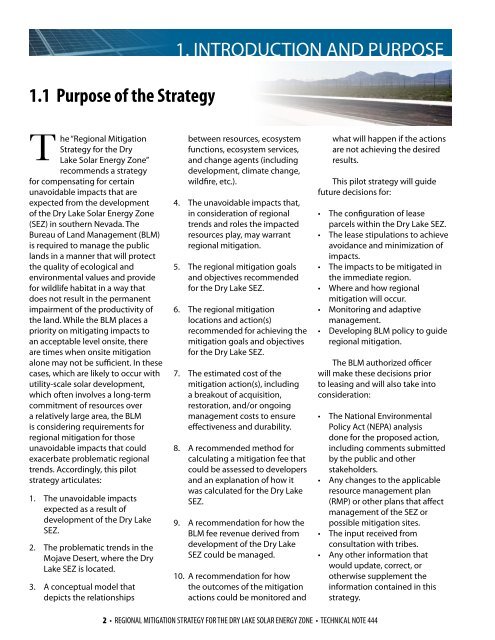xs7hy9e06w?redirect_to=http://www.blm.gov/pgdata/etc/medialib/blm/wo/blm_library/tech_notes.Par.29872.File.dat/TN_444
xs7hy9e06w?redirect_to=http://www.blm.gov/pgdata/etc/medialib/blm/wo/blm_library/tech_notes.Par.29872.File.dat/TN_444
xs7hy9e06w?redirect_to=http://www.blm.gov/pgdata/etc/medialib/blm/wo/blm_library/tech_notes.Par.29872.File.dat/TN_444
You also want an ePaper? Increase the reach of your titles
YUMPU automatically turns print PDFs into web optimized ePapers that Google loves.
1.1 Purpose of the Strategy<br />
1. INTRODUCTION AND PURPOSE<br />
The “Regional Mitigation<br />
Strategy for the Dry<br />
Lake Solar Energy Zone”<br />
recommends a strategy<br />
for compensating for certain<br />
unavoidable impacts that are<br />
expected from the development<br />
of the Dry Lake Solar Energy Zone<br />
(SEZ) in southern Nevada. The<br />
Bureau of Land Management (BLM)<br />
is required to manage the public<br />
lands in a manner that will protect<br />
the quality of ecological and<br />
environmental values and provide<br />
for wildlife habitat in a way that<br />
does not result in the permanent<br />
impairment of the productivity of<br />
the land. While the BLM places a<br />
priority on mitigating impacts to<br />
an acceptable level onsite, there<br />
are times when onsite mitigation<br />
alone may not be sufficient. In these<br />
cases, which are likely to occur with<br />
utility-scale solar development,<br />
which often involves a long-term<br />
commitment of resources over<br />
a relatively large area, the BLM<br />
is considering requirements for<br />
regional mitigation for those<br />
unavoidable impacts that could<br />
exacerbate problematic regional<br />
trends. Accordingly, this pilot<br />
strategy articulates:<br />
1. The unavoidable impacts<br />
expected as a result of<br />
development of the Dry Lake<br />
SEZ.<br />
2. The problematic trends in the<br />
Mojave Desert, where the Dry<br />
Lake SEZ is located.<br />
3. A conceptual model that<br />
depicts the relationships<br />
between resources, ecosystem<br />
functions, ecosystem services,<br />
and change agents (including<br />
development, climate change,<br />
wildfire, <strong>etc</strong>.).<br />
4. The unavoidable impacts that,<br />
in consideration of regional<br />
trends and roles the impacted<br />
resources play, may warrant<br />
regional mitigation.<br />
5. The regional mitigation goals<br />
and objectives recommended<br />
for the Dry Lake SEZ.<br />
6. The regional mitigation<br />
locations and action(s)<br />
recommended for achieving the<br />
mitigation goals and objectives<br />
for the Dry Lake SEZ.<br />
7. The estimated cost of the<br />
mitigation action(s), including<br />
a breakout of acquisition,<br />
restoration, and/or ongoing<br />
management costs to ensure<br />
effectiveness and durability.<br />
8. A recommended method for<br />
calculating a mitigation fee that<br />
could be assessed to developers<br />
and an explanation of how it<br />
was calculated for the Dry Lake<br />
SEZ.<br />
9. A recommen<strong>dat</strong>ion for how the<br />
BLM fee revenue derived from<br />
development of the Dry Lake<br />
SEZ could be managed.<br />
10. A recommen<strong>dat</strong>ion for how<br />
the outcomes of the mitigation<br />
actions could be monitored and<br />
what will happen if the actions<br />
are not achieving the desired<br />
results.<br />
This pilot strategy will guide<br />
future decisions for:<br />
• The configuration of lease<br />
parcels within the Dry Lake SEZ.<br />
• The lease stipulations to achieve<br />
avoidance and minimization of<br />
impacts.<br />
• The impacts to be mitigated in<br />
the immediate region.<br />
• Where and how regional<br />
mitigation will occur.<br />
• Monitoring and adaptive<br />
management.<br />
• Developing BLM policy to guide<br />
regional mitigation.<br />
The BLM authorized officer<br />
will make these decisions prior<br />
to leasing and will also take into<br />
consideration:<br />
• The National Environmental<br />
Policy Act (NEPA) analysis<br />
done for the proposed action,<br />
including comments submitted<br />
by the public and other<br />
stakeholders.<br />
• Any changes to the applicable<br />
resource management plan<br />
(RMP) or other plans that affect<br />
management of the SEZ or<br />
possible mitigation sites.<br />
• The input received from<br />
consultation with tribes.<br />
• Any other information that<br />
<strong>wo</strong>uld up<strong>dat</strong>e, correct, or<br />
otherwise supplement the<br />
information contained in this<br />
strategy.<br />
2 • REGIONAL MITIGATION STRATEGY FOR THE DRY LAKE SOLAR ENERGY ZONE • TECHNICAL NOTE <strong>444</strong>


